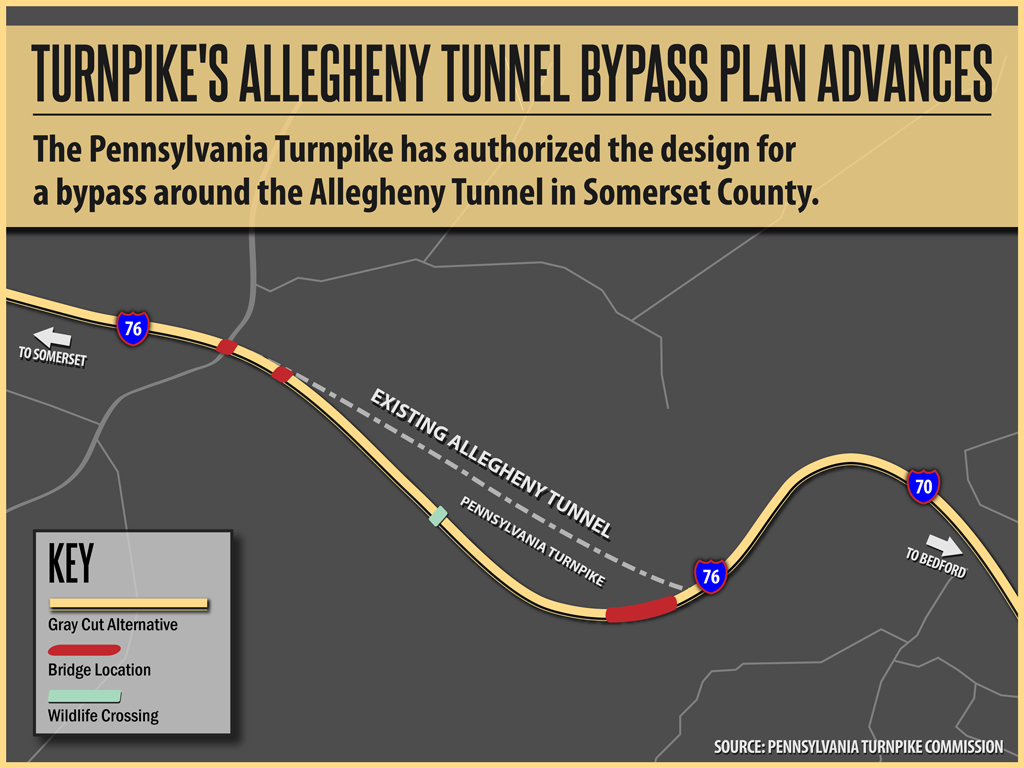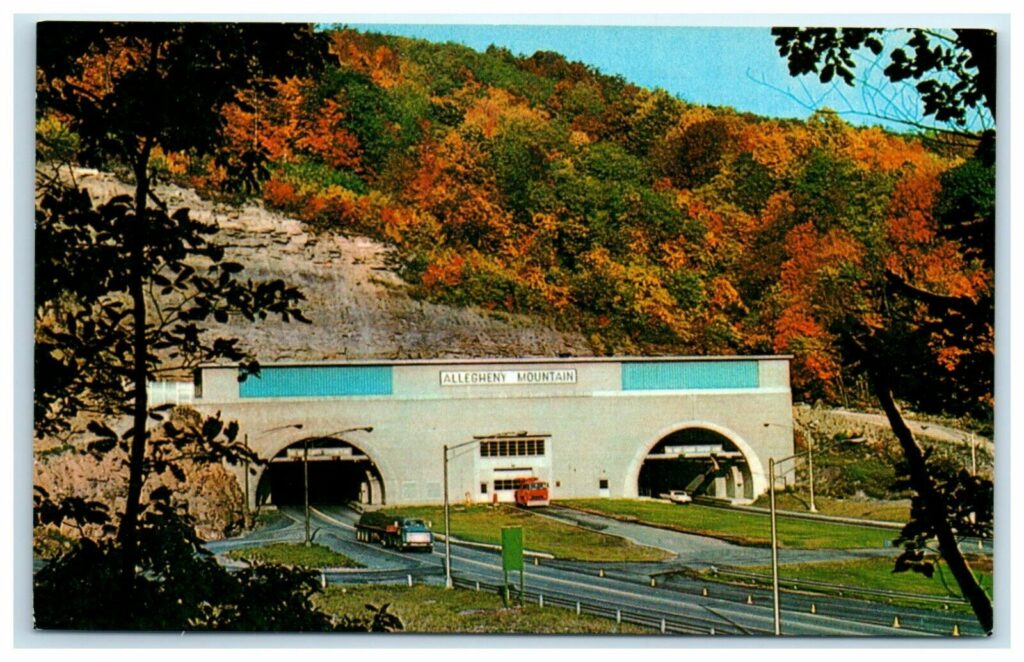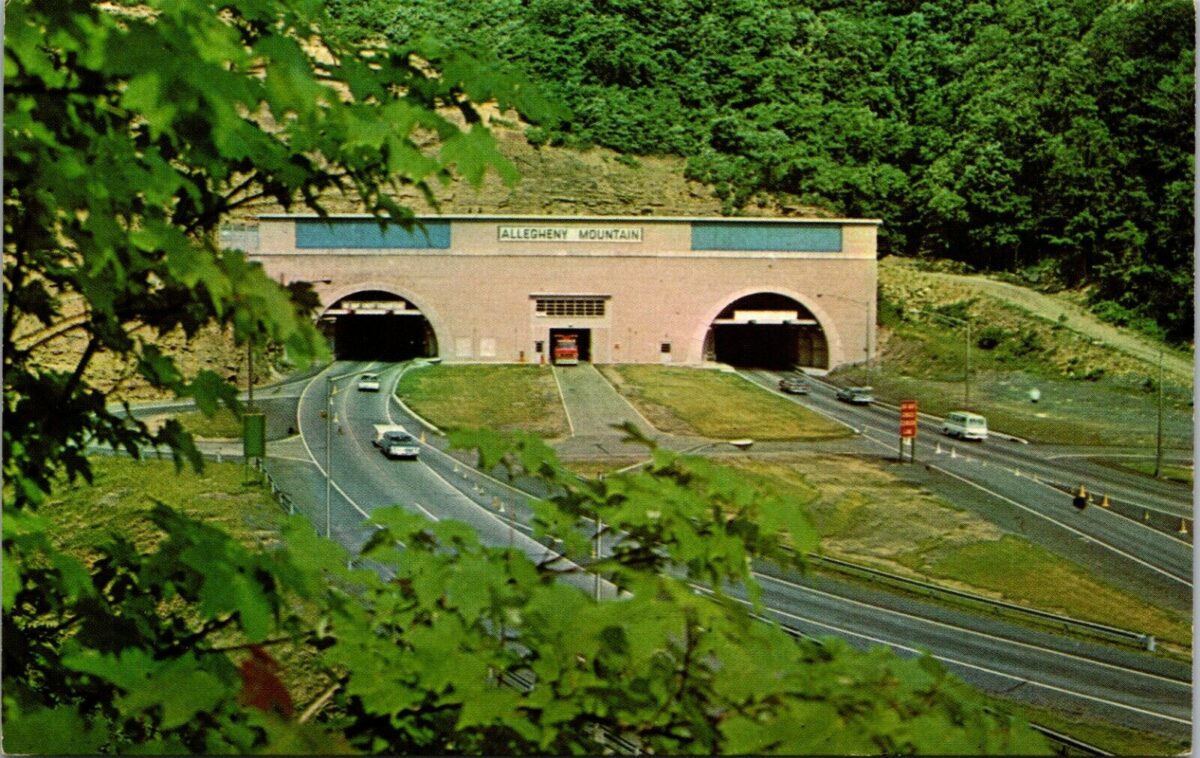The Pennsylvania Turnpike Commission took a major step forward in its decades-long effort to eliminate the Allegheny Tunnel in Somerset County last week by hiring a firm to design a 3.8-mile road around the tunnel.
There are still major challenges ahead for the half-billion-dollar project that could take 10 years to design and build. They include strong political and community opposition to the project, which raises environmental concerns because it would cut through the Mountain Field and Stream Club in Stoneycreek.
The commission approved a contract not to exceed $16 million with McMahon Associates, a national engineering and design firm with regional offices in Wilkins and Philadelphia. The company is expected to take four years or more to design the exact path for the bypass road, and four years of construction could begin in 2030.
The project is currently estimated to cost $400 million, but the price tag could reach $500 million by the time it is built, said Brad Heigel, the turnpike’s chief engineer.
“As I told the commissioners, this is a major step forward,” Heigel told the Union Progress. “There are a lot of challenges out there. We settled on this as the best alternative.”
The turnpike has been working since at least the early 1990s to find a solution to problems with the Allegheny Tunnel, the first one reached by motorists as they head east on the turnpike from the Pittsburgh area. Traffic, safety and the cost of refurbishing and operating the tunnel are among the factors that caused the turnpike to look for alternatives.
Three years ago, the agency presented three potential paths, each one with an option for a new road or a new tunnel. They included two northern routes and one southern route, and the agency chose the southern road option because it was projected to be the least expensive and had the fewest environmental concerns, Heigel said.

Long history
The westbound tunnel was part of the turnpike’s original construction in 1939, and the eastbound portal was added in 1965. The tunnel has had numerous upgrades over the years, including $20.7 million three years ago for new lighting and electric conduit.
But Heigel said the agency decided to eliminate the tunnel for a series of reasons: The general condition of the tunnel still needs to be upgraded; traffic volume and accident rates are too high; sharp curves approaching from the west no longer meet design standards; trucks carrying hazardous loads aren’t permitted in the tunnel; and the turnpike wants to get out of the tunnel business because each tube costs about $1 million a year to operate.
The agency’s current plan for an alternate route would cut into the mountain about 1,000 feet south of the tunnel, but McMahon engineers will choose the final path after conducting test borings. Coming from the west, the 3.8-mile road will flatten out the sharp curves before the tunnel in Allegheny Township, ride around the edge of the mountain and then rejoin the existing road about a half mile west of the tunnel.
The project to create the new road is expected to involve the removal of more than 10 million cubic yards of material. It will have three bridges — a long curved bridge in Allegheny Township near the existing eastern end of the tunnel, and two smaller ones near where it will rejoin the mainline on the western side in Stoneycreek.
The project also will install a wildlife crossing bridge above the highway at about the midpoint of the existing tunnel, as well as stormwater facilities. The land is mostly grown over now but may have been used for strip mining or lumbering in the distant past.
“There are so many unknowns in this project right now,” Heigel said. “And that’s some of the toughest area of the turnpike to work on in the winter, so when we reach construction it will take some time to complete.”
Heigel stressed that upgrading the existing tunnel and adding another port “really isn’t an option,” not only due to the cost but also because there is so much traffic in the area that the agency can’t close one portal for work and put two-way traffic in the other. That’s what it is doing to upgrade the Tuscarora Tunnel at the border of Huntingdon and Franklin counties, but there is less traffic in that area.
“At Allegheny, we wouldn’t have that opportunity because of the traffic,” he said. “What drives a lot of our discussion is traffic control and how we can keep our customers moving.”
Strong opposition
Although the turnpike has chosen the general path it wants to follow, the project continues to face strong political and community opposition from the Mountain Field and Stream Club, Somerset County commissioners and the borough of Berlin, a tiny Somerset County community where residents fear the water supply will be threatened by the highway.
The field and stream club, which has about 500 members, dates back to the 1930s and covers about 1,800 acres, 1,400 that it owns and 400 that it leases. The organization has been fighting the road project for decades, fearing that cutting as much as 300 feet deep into the mountain will have a strong negative effect on the prime hunting land and the high-quality cold-water fisheries in tributaries of the Juniata River.
Andy Musser, who chairs the club’s turnpike committee, said it’s not clear yet how much land the turnpike would need for the new road, but because of the agency’s power of eminent domain it likely couldn’t stop the state from taking the land for a fair price. Musser’s family has lived in the area for several generations and donated some of the club’s original land.
Instead, the club and others will challenge the environmental impact of the project and try to prevent the turnpike from getting the federal permits it needs. He believes the agency was set on building a road rather than a tunnel all along, and calls the wildlife crossing “window dressing” that would do little to mitigate the damage.
The club would prefer installing another tunnel, which Musser said would “solve all the problems” by reducing environmental concerns and providing room for more traffic.
“Anyone who sees that mountain and knows what it is like knows the damage this will do to that area,” Musser said. “They have to demonstrate they can mitigate the damages, and there will be a lot of damages.”
The three-member Somerset County board of commissioners also opposes the new road, including chairman Gerald Walker. Walker, who also currently serves as field club president, couldn’t be reached for comment.
Heigel said the turnpike is aware of the concerns, but the agency is prepared to do the environmental work necessary for the project to proceed. There will be a series of public meetings and online presentations about the project over the next few years as plans are developed, he said.
“I’m not trying to downplay the work ahead. We have some challenges,” Heigel said. “I think it’s up to us to work with them to find a viable solution that satisfies everyone as much as possible. We always want to be good neighbors and will do everything we can.”

Ed covers transportation at the Pittsburgh Post-Gazette, but he's currently on strike. Email him at eblazina@unionprogress.com.



